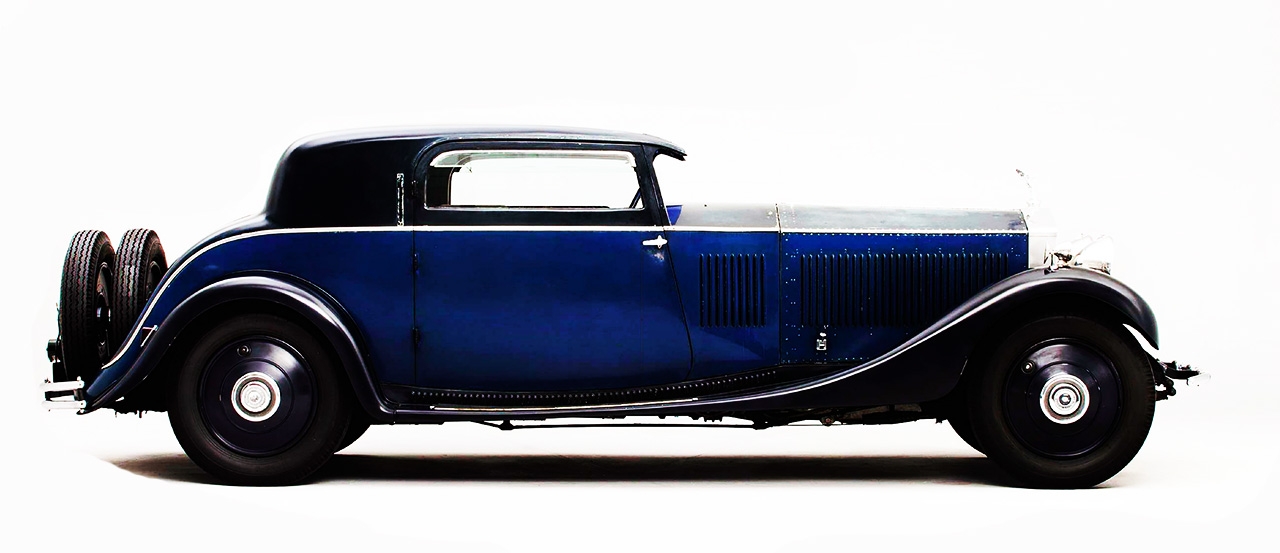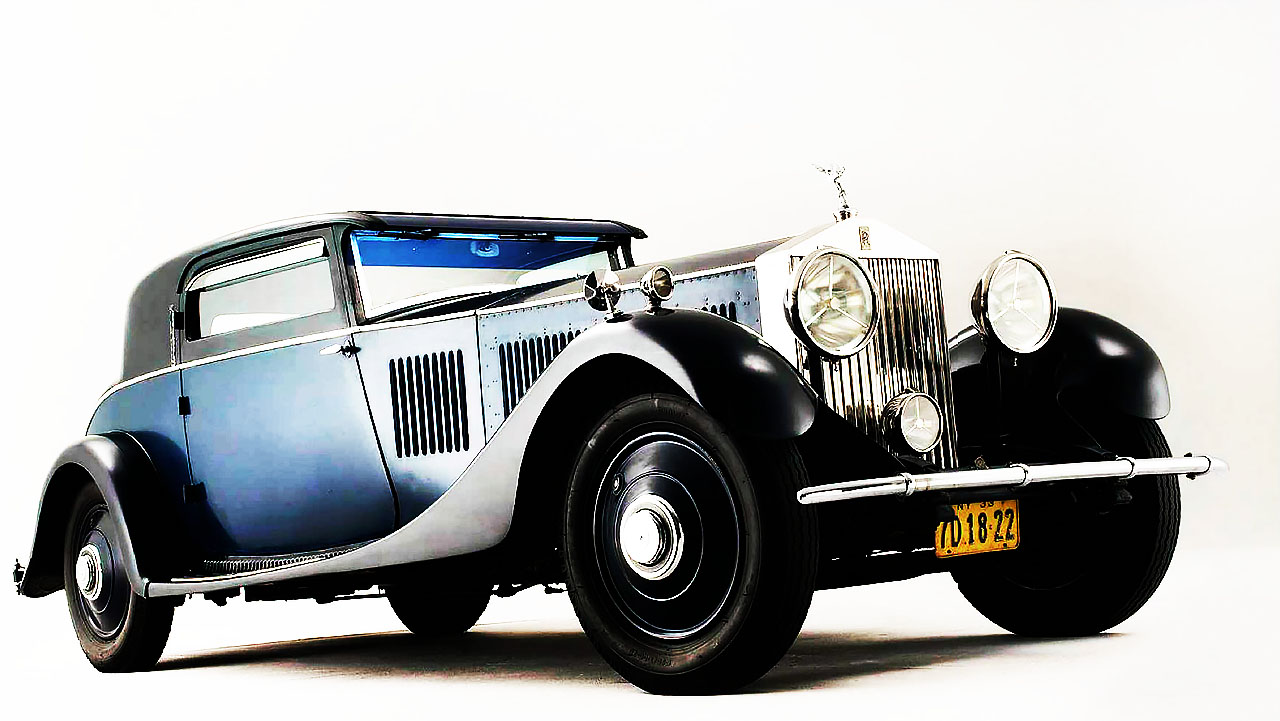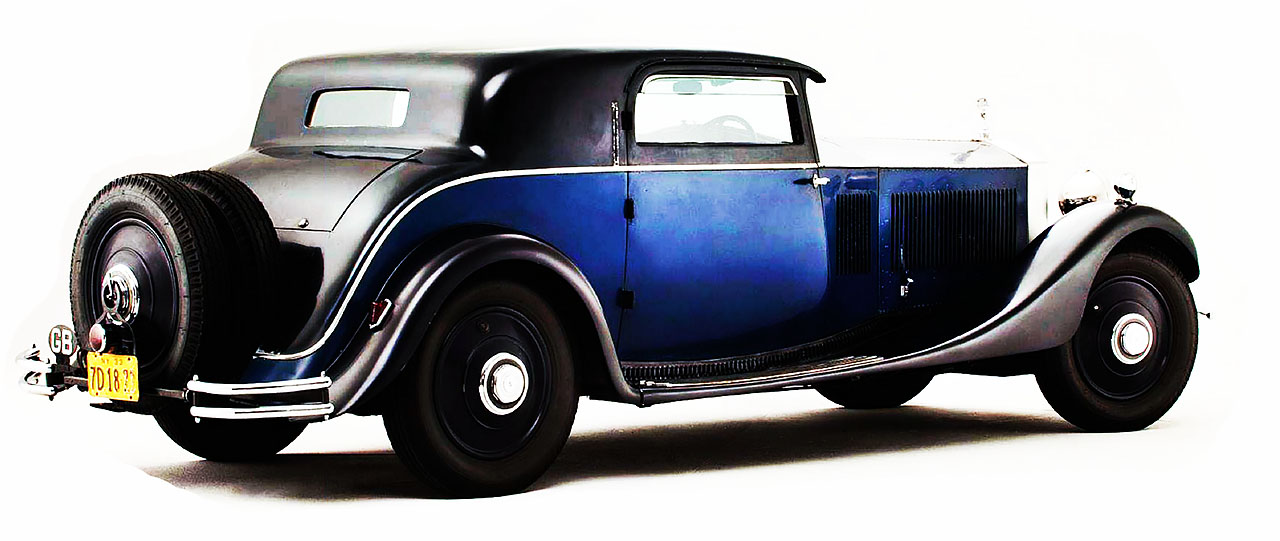
Revisiting an old haunt Rolls-Royce Phantom II. Timewarp Derby elegance returns to the world’s most glamorous concours. Graeme Hurst tells the fascinating story of a gloriously original Rolls-Royce Phantom II that last year went back to Pebble Beach, 80 years after its first appearance. Photography James Mann.
Cars seldom reappear at Pebble Beach. The famous ‘no return for 10 years’ policy aside, the annual concours d’elegance on the 18th fairway of one of the world’s finest golf courses is seriously oversubscribed. An invitation remains the ultimate accolade for any serious classic collector.

But last year a 1932 Rolls-Royce Phantom II Continental – one of the standouts in the array of preservation classes – quietly returned to Monterey nearly 80 years after its owner drove it from New York, before enjoying a round of golf with his chums. And the Royce still sports the same paintwork that it wore when it was parked outside the clubhouse in autumn 1933.
The chance to take in a few holes was a highlight of the 10,000-mile round-trip across the States in the then newly acquired beauty. The car was subsequently shipped back to England and has remained in timewarp condition, thanks to a series of owners who have all coveted its amazing originality and history.
The coast-to-coast epic was to enable the car’s 27-year-old owner Robin McAlpine – later Sir Robin, a noted racehorse breeder, of the Robert McAlpine construction empire – to visit numerous civil-engineering projects across the US.
He was accompanied by friends Max and Olive but this was no wealthy cads’ sightseeing jaunt. The trio covered around 450 miles a day on the three-week marathon, while negotiating harsh stretches of gravel roads, avoiding dust storms that threatened to strip the Rolls’ body-work and outrunning a Greyhound bus.
They also traversed the Rockies, mingled with cowboys and endured the heat of the Nevada desert – in a car that cost more than twice the price of the average family home – across a landscape rife with gangsters keen on snaring an easy ransom. It’s akin to taking the latest Phantom Coupe on a drive from Moscow to Vladivostok.

The Phantom II was launched in 1929 and was more advanced than its predecessor (known latterly as the Phantom I) had been when it superseded Rolls-Royce’s long-running Ghost in 1925. The second-generation Phantom featured an 8-10in lower chassis, with all-round semi-elliptic leaf springs and a subframe-mounted body among its array of refinements.
The Phantom’s six-cylinder overhead-valve engine remained unchanged at an already lofty 7668cc, but the alloy head over twin cast-iron block units was bolted directly to the gearbox via a bell-housing. Meanwhile, the back axle was switched from a spiral bevel-gear to a hypoid type, to reduce the ride height.
Other innovations included the one-shot centralised chassis-lubrication system – a Rolls-Royce constant until the advent of the Cloud III – while the Derby-based company would later introduce the self-cleaning engine oil filter (operated whenever the clutch pedal was depressed) during the model’s life. As with the Phantom II’s older siblings, the chassis was available with a short (144in) or long (150in) wheelbase for a cost of £1850 or £1900.
But it was the new Continental version that customers really aspired to own. Although the term was never officially coined by the company, the Continental specification came about after it started preparing models for journeys to Europe, where customers wanted to indulge in higher speeds and enjoy crossing the Alps.
Typically (but not exclusively) offered on the shorter chassis, to enable lighter coachwork, the model featured a low scutde line – thanks to the decreased rake of the F-type steering box – and stiffer springing to improve handling. Some of these attributes were offered with the London-to-Edinburgh and Alpine Eagle Ghosts, but the Phantom II Continental was, in effect, the first high-performance Rolls-Royce.
And, as was the case with all of its pre-war models, the company only offered a rolling chassis, leaving the bodywork, typically, to a coachbuilder of the customer’s choosing.
McAlpine selected Windovers (which bodied only four of the 281 Phantom II Continental chassis) for his car when he placed an order early in 1932. He chose the close-coupled coupe style from the Hendon coachbuilder, which his family had used for other vehicles.
The two-door coachwork certainly amplifies the Continental model’s sporting intent, with its long bonnet (it’s 6ft from the ’screen to the front of the grille), deep scuttle – complete with vents to emphasise the bonnet’s length – and low, pillar-box ’screen giving it the decadence fit for a role in F Scott Fitzgerald’s The Great Gatsby.
McAlpine’s odyssey began with the car being delivered to Manhattan’s Waldorf Hotel where its siren – a required fitment in the UK, specified so its owner could warn little cars of his approach – was accidentally sounded after the parking attendant confused it for the car’s electric starter. Evidently, the klaxon was quickly removed at the instruction of the local police chief.
THE TRIP ACROSS THE STATES LED THEM OVER THE ROCKIES, WHERE IT DIDN’T SKIP A BEAT
McAlpine and friends set off west via Washington DC in mid-October. Along the way the trio were impressed by the quality of America’s vast Interstate road network, which, even by the early ’30s, often featured concrete construction and two or more lanes on either side.
They were also amazed by the abilities of American vehicles: in particular, the performance of Greyhound buses. McAlpine noted, in an account of the trip, that at 65mph the bus was gaining on them, at 70 they were just about level and that he had to go up to 85 to keep ahead.
The Phantom was an equal source of fascination with locals. Many had never before clapped eyes on a car bearing the Spirit of Ecstasy, as the friends realised when the shocked staff and patrons of a restaurant in Lexington, Virginia rushed out to see them depart for Chicago.
Their journey across to San Francisco led them through Kansas City and the Rockies, where the Rolls-Royce didn’t skip a beat despite the thin air at the power-sapping altitudes, which included a 10,038ft pass during a drive through Colorado’s Rio Grande National Forest.
They made it to Los Angeles in 18 days after a break in Las Vegas and a trip to the Grand Canyon, plus detours to visit various civil-engineering projects. Once in the City of Angels, the Phantom was apparently a regular feature in the parking lots along Sunset Boulevard as the young English visitors were wined and dined in Tinseltown, rubbing shoulders with stars such as Mae West and Spencer Tracy.
From there, they headed up California’s famous Pacific Coast Highway 1 to San Francisco, where the Phantom was often limited to second gear as it tackled the city’s hills. Next, of course, was the Monterey Peninsula.
The car covered the miles with barely a hitch. The only time that it ‘failed to proceed’ was in Palm Springs where – as McAlpine mused – the humiliation of having to be tow-started by a humble Ford seemed to ensure reliability from then on. Service-wise the Royce needed little, apart from a set of plugs once they reached the West Coast and a couple of oil changes.
On their return drive to the East Coast, the Phantom recorded some impressive figures, too: the car comfortably covered 466 miles per day over the 3267-mile journey, at an average speed of 50mph – excluding time for refuelling and lunch stops. Those distances would surely be taxing even in the latest Phantom.
McAlpine shipped the car back across the pond shortly after the marathon and is believed to have not parted with it until post-WW2 – using it for a run to the South of France at one point – before Rolls-Royce records show a change of ownership to a Dr Haine in 1948.
The Continental was subsequently owned by noted dealer Jack Lemon-Burton (who had a Bugatti Royale at one point) before being acquired by marque aficionado Edward Burkhart in the late ’50s. He kept it for 25 years, adding around 1000 miles a year to the Phantom’s odometer, which still shows just 58,437 miles.
Burkhart cherished the car’s condition and evidence of proper use – frowned upon by some Rolls-Royce Enthusiasts’ Club members in the early ’80s, when ‘boiled sweet’ restorations were all the rage.
It was the coachbuilt Roller’s magnificent presentation that also caught the attention of the next owner, an American collector living in London. He tracked down Burkhart’s address after seeing the car at a show and mailed him a succession of tempting cheques before he persuaded Burkhart to hand over the logbook.
The 17ft 11 in Continental was later stored on a Persian rug as the showpiece of a varied private display before finding its way – via another local collector, who carefully recommissioned the car and then sold it – to Derek Hood of Maldon- based JD Classics in Essex.
Mindful of its amazing past, Hood’s only intervention has been to replace the wiring, which was too far gone for the car to be safely used, and to fabricate a correct replacement front bench seat in West of England cloth – the original having being removed to accommodate a couple of bucket seats during Burkhart’s tenure. Today the car wears its patina from its remarkable coast-to-coast odyssey and decades of subsequent careful ownership as graciously as Sophia Loren carries her 50-plus years of appearing on the silver screen.
The two-tone cellulose that Windovers applied 80 years ago is worn in places – notice-ably on the tops of the doors where the blue is showing through the black overcoat and on the top of the bonnet, presumably from die engine heat – but the wear adds to the Phantom’s captivating aura. The appearance is complemented by the aged nickel brightwork, often overrestored when cars are refurbished.
Opening the 4ft 1in triple-hinged door reveals a footplate that reminds you of just how revered these cars were in pre-war days. It is engraved with the hallmarks of three Royal appointments: Windovers enjoyed Royal patronage from King George V, the Prince of Wales and the King of Spain – along with King Haakon of Norway.
Seated behind the substantial 18in-diameter, broad-rimmed steering wheel (which McAlpine stipulated), the combination of the heavily curved dashboard and centrally placed instruments certainly has a cockpit-like character – as if you’ve strapped yourself into a 1930s Hawker Demon fighter aircraft.
The aviation feel continues when you coax the massive engine into life: Rolls-Royce fitted a dual-ignition system to go with the then-new ‘make and break’ circuit-breaker coil and distributor operating in parallel with a traditional magneto. So you need to turn on the magneto, along with the ignition and the fuel taps on the Autovac mechanism and one for the starting carburettor. Then the wheel-mounted timing lever needs a nudge to the ‘early’ position and the mixture control a shift to ‘strong’ before it’s time to thumb the large Bakelite starter button.
The six-cylinder motor churns with a soft chuffing before purring into life, emitting a barely discernable pulse through the car. Rolls-Royce would never divulge just how much power the engine developed, but factory records for this car reveal a dynamometer reading of 199lb ft at just 500rpm. With such flexibility, the Phantom II glides off the mark easily, although you soon need second gear – along with a carefully matched input from your right foot if you’re to avoid an ear-wincing crunch from the synchromesh-free cogs below.
Gearchanges with the right-hand-mounted lever require a deliberate movement through the sturdy mechanical gate and the high-geared steering (part of the Continental spec) is decidedly heavy in sharp corners. The brake pedal can be alarming, too, with the degree of movement before the mechanical drums do their work.
Once the Continental has picked up speed, however, it lopes along in top happily enough, taking in undulating terrain with ease. Acceleration is impressive for such a large car and, although the Continental seems as if it could nudge the ton – Burkhart reportedly had it over 90mph on the A3 on a regular basis – 55-65mph is a comfortable cruising gait.
The driving position – with your legs outstretched, tucked under the dashboard – is both ensconced and splendid. It’s all the more enhanced by the majestic view across the bonnet, divided by the proud Spirit of Ecstasy – a figure that must have appeared almost other-worldly to many an American as it sliced its way across the Midwest nearly 80 years ago.
Thanks to Derek Hood of JD Classics
THE CAR WEARS ITS PATINA AS GRACIOUSLY AS SOPHIA LOREN HER DECADES ON SCREEN ROLLS-ROYCE PHANTOM II
Above: 20in wheels feature plain yet stylish hubcaps. Below: Royce sports evocative 1933 New York licence plate at rear on double spare wheels.
Remarkable Phantom II sports its blemishes with dignity; its desirable Continental spec was intended for demanding motorised Grand Tours.
Clockwise, from above: Spirit of Ecstasy adorns huge radiator surround – clever thermostatically controlled grille vanes open to increase cooling; cabin is luxurious yet understated – mixture and timing levers in centre of the wheel; neat cover for starting-handle dog – big ‘six’ is fired electrically.
| Car | Rolls-Royce Phantom II |
| Made in | UK |
| Sold | 1929-1935 |
| Number built | 281 (to Continental specification) |
| Construction | steel chassis, with aluminium coachwork over a timber frame |
| Engine | iron-block, aluminium-head, overhead-valve 7668cc straight-six, with single carburettor plus magneto and coil ignition |
| Max power (DIN) | not disclosed |
| Max torque (DIN) | 199lb ft @ 500rpm |
| Transmission | four-speed manual, driving rear wheels |
| Suspension | front beam axle rear live axle; semi-elliptic leaf springs, friction dampers f/r |
| Steering | worm and nut |
| Wheels | Wheels & tyres wires with hubcaps, Dunlop 6.50/700×20 crossplies |
| Brakes | mechanically operated drums |
| Measurements | |
| Length | 17ft 11in (5450mm) |
| Width | 6ft (1828mm) |
| Height | 5ft 4in (1640mm) |
| Wheelbase | 12ft 6in (3657mm) |
| Weight | 5488lb (2489kg, saloon) |
| Power to weight | – |
| 0-62mph | 19.6 secs |
| Top speed | 96mph |
| Mpg | 10-14 |
| Price new | £1900 (chassis only) |
| Price now | £650,000 |





